To understand furniture and deck loads by the edge, you need to contemplate how weight distributes across your deck. Proper placement of furniture, especially heavy or unbalanced pieces, can cause stress or damage at support points. Recognize various loads like dead, live, and dynamic loads, and use appropriate materials and reinforcement to strengthen vulnerable edge areas. Continuing will reveal how to better design and maintain your deck for safety and durability.
Key Takeaways
- Proper load distribution from furniture and objects prevents uneven stress and deck failure.
- Recognize load types—concentrated, uniform, and dynamic—to inform reinforcement needs.
- Reinforce edges with additional supports, thicker materials, or metal brackets for enhanced stability.
- Regular inspections and maintenance help identify early signs of structural stress or damage.
- Adhering to building standards and considering environmental factors ensures safe, durable deck and furniture support.
Understanding Load Distribution on Deck Edges
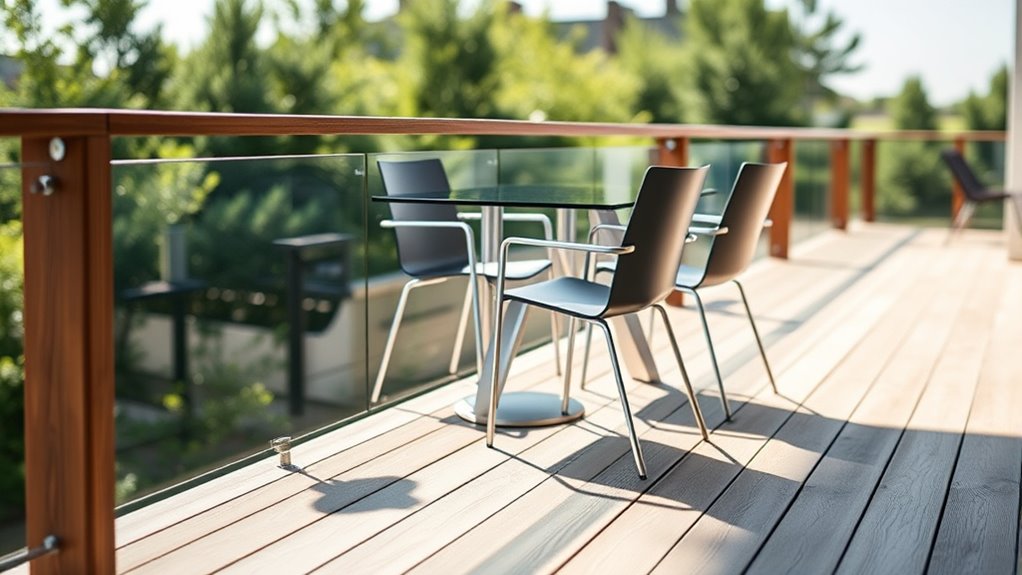
Understanding how loads distribute on deck edges is essential for ensuring your deck’s stability. When weight is applied near the edge, it creates a concentrated force that can cause stress and potential failure if the deck isn’t properly designed. You need to take into account how the load from furniture, people, or other objects spreads across the deck surface. The deck’s framing, joists, and support beams work together to transfer these loads safely to the ground. Heavier loads or uneven placement can increase stress on the edges, so understanding load paths helps you prevent overloading and structural damage. Properly distributing weight across the deck surface ensures stability, safety, and longevity, especially when loads are concentrated near the edges.
The Impact of Furniture Placement on Structural Support

Where you place furniture can create uneven load concentrations that strain your deck’s support system. To prevent issues, it’s important to use weight distribution strategies and avoid overloading specific areas. Sometimes, structural reinforcement may be necessary to guarantee your deck stays safe and sturdy.
Load Concentration Effects
When furniture is placed unevenly or heavily concentrated in specific areas of a deck or floor, it can create localized stress points that challenge the structural support system. These concentrated loads can cause the supporting beams or joists to bear more weight than intended, increasing the risk of deformation or failure. Over time, continuous pressure on a small area can weaken the material, leading to cracks or sagging. This effect is especially critical near edges or unsupported spans, where the structure is less equipped to handle uneven weight distribution. To prevent damage, avoid piling heavy furniture in one spot. Instead, distribute the weight evenly across the deck or floor, reducing stress concentrations and promoting longevity of your structure. Additionally, implementing proper organization and layout can help distribute weight effectively, minimizing the risk of uneven load buildup.
Weight Distribution Strategies
Proper furniture placement is essential for maintaining the structural integrity of your deck or floor. Distributing weight evenly prevents stress concentrations that can cause damage. To achieve this, spread furniture and heavy objects across different areas instead of clustering them in one spot. Use a strategic layout to balance loads, especially near edges and supports. Consider placing heavy items closer to load-bearing beams and lighter items in less critical zones. Here’s a simple guide:
| Furniture Type | Placement Strategy | Impact on Support |
|---|---|---|
| Sofa | Centered, balanced | Even load distribution |
| Dining Table | Near support beams | Reduces concentrated stress |
| Lounge Chairs | Scattered evenly | Maintains stability |
| Bar Cart | Close to edge | Minimize edge load |
| Planters | Distributed evenly | Prevents uneven weight |
Following these strategies helps safeguard your deck’s structure. Additionally, understanding weight distribution strategies is key to ensuring long-term durability.
Structural Reinforcement Needs
Because furniture placement directly influences how weight loads are distributed across your deck or floor, it can considerably impact the need for structural reinforcement, especially in areas bearing concentrated or uneven loads. If you place heavy furniture or multiple pieces in one spot, you may create stress points that exceed your deck’s designed capacity. Over time, this can lead to sagging, warping, or even structural failure. To prevent this, assess the weight distribution regularly and consider reinforcing weak areas with additional supports, beams, or joists. Proper reinforcement ensures your deck can handle the load safely and maintains its integrity. Additionally, understanding industry trends helps in planning and reinforcing your deck appropriately. If you’re unsure about your deck’s capacity, consulting a structural engineer can help determine necessary reinforcements based on your furniture placement.
Types of Loads Commonly Encountered at the Edges

Have you ever wondered what types of loads are most common at the edges of furniture and decks? Typically, you’ll encounter concentrated loads, where weight is focused on a small area, like a person sitting on the corner of a bench or placing a heavy object near the edge. Uniform loads are also common, distributing weight evenly across a surface, such as a deck plank supporting furniture and foot traffic. Moment loads occur when force creates bending stresses at the edge, especially if someone leans or shifts weight suddenly. Additionally, dynamic loads from movement or shifting furniture can cause fluctuating stresses. Recognizing these load types helps you understand the demands placed on edge support structures and guides appropriate design and reinforcement. The types of dog names you choose can reflect the personality and character that might influence how your pet interacts with their environment.
Calculating Live and Dead Loads for Edge Support
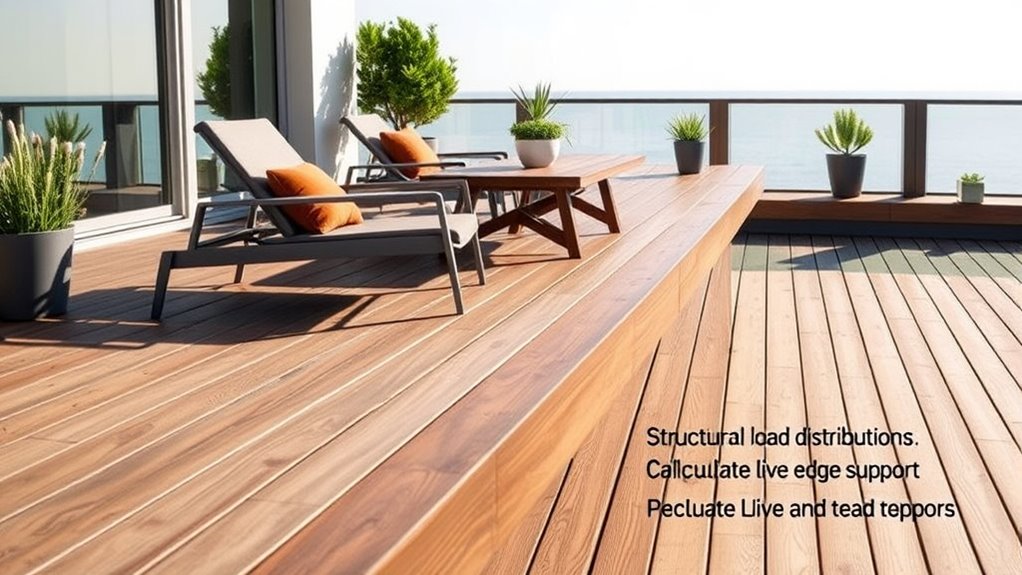
To guarantee your edge support can handle the loads, you need to understand load distribution techniques. Accurate weight estimation methods help you determine both live and dead loads reliably. Mastering these points is essential for designing safe and sturdy furniture and deck supports. Utilizing appropriate load tracking tools can further enhance your accuracy and confidence in the calculations.
Load Distribution Techniques
When calculating live and dead loads for edge support, it’s essential to understand how these forces are distributed across the structure. You should identify whether loads are concentrated or spread evenly, as this impacts support design. Dead loads, like the weight of the structure itself and furniture, tend to be fixed and predictable. Live loads, such as furniture or people, fluctuate and may be unevenly distributed. To ensure safety, you need to contemplate load distribution techniques, such as load sharing and transfer methods. Using proper framing, beams, and support points helps distribute loads effectively, preventing stress concentrations. Visualize how loads flow from the surface to the supports. Proper load distribution ensures the structure remains stable and durable under varying load conditions. Additionally, understanding the contrast ratio of supporting materials can influence how loads are managed and visualized in the structure.
Weight Estimation Methods
Estimating the weights of live and dead loads is essential for designing effective edge supports. To do this, start by identifying the types of loads your structure will experience. Dead loads include the weight of the deck materials, furniture, and fixtures, which you can find in manufacturer specifications or building codes. Live loads come from furniture, people, and movable objects; use standard load values from local codes or industry guidelines. For furniture and deck furniture, estimate weight based on typical sizes and materials. Use conservative figures to ensure safety margins. Calculating these loads accurately helps determine the necessary support capacity, preventing structural failure. Always cross-reference your estimates with local building standards for precise, compliant design. Additionally, understanding the climate control needs of your environment can influence material choices and load considerations, especially in regions with extreme weather conditions.
Material Selection and Its Role in Load Management
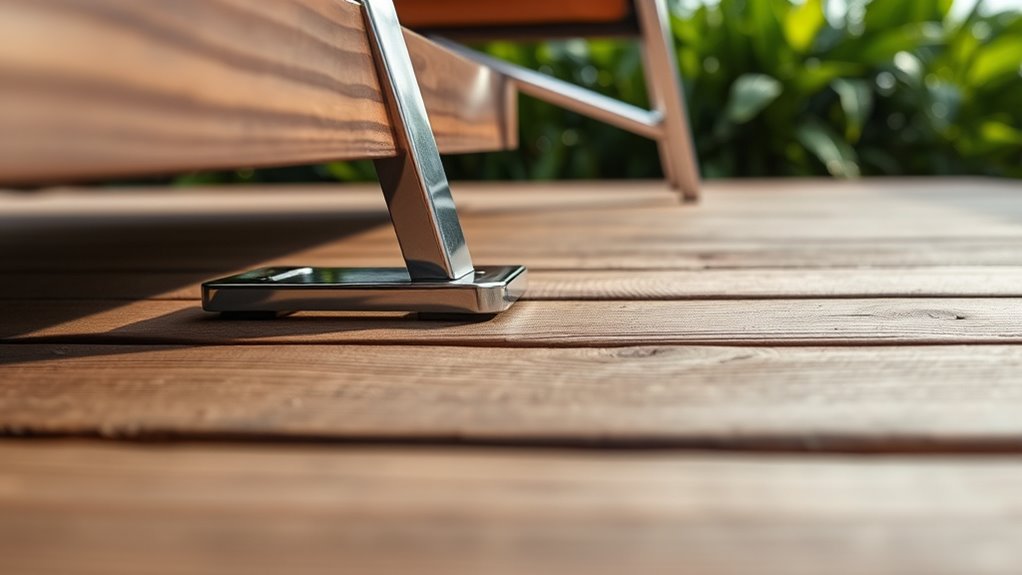
Choosing the right materials is essential for managing load effectively in furniture and deck construction. The strength and durability of your materials directly influence how well they can support weight without bending or breaking. For decks, select wood types like cedar or pressure-treated lumber that resist warping and can handle heavy loads. For furniture, opt for high-quality plywood, solid wood, or engineered composites designed to withstand frequent use. Material properties such as density, elasticity, and moisture resistance affect load distribution and longevity. Using appropriate materials helps prevent structural failures and reduces maintenance needs. Always consider the weight capacity of your chosen materials relative to the expected loads. Additionally, understanding the material properties involved in construction helps in selecting options that best suit your specific load requirements. Proper material selection ensures safety, enhances durability, and optimizes load management in your construction projects.
Design Strategies for Reinforcing Edge Areas
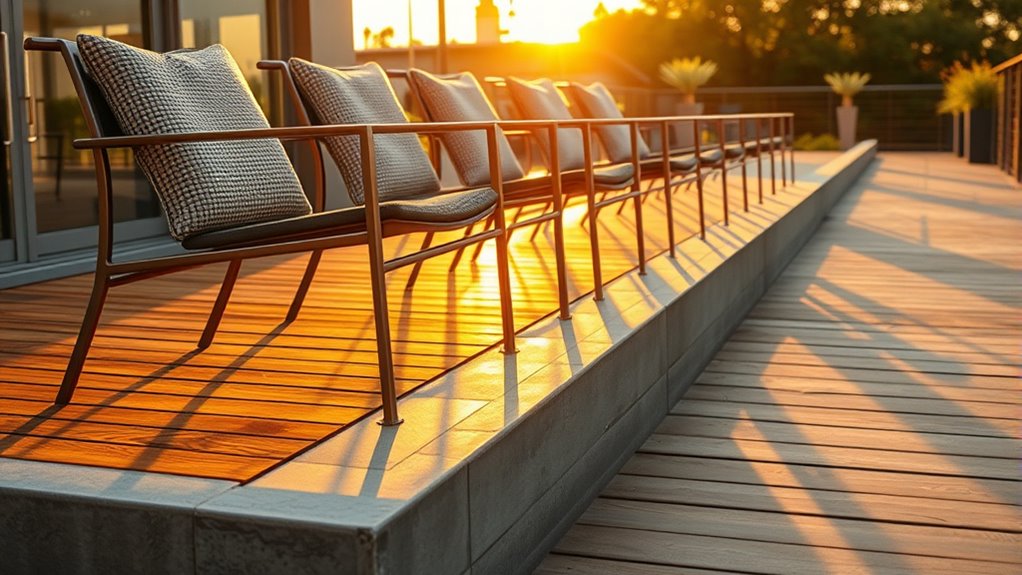
Reinforcing edge areas is essential for maintaining the structural integrity of furniture and decks, especially under heavy loads or frequent use. To strengthen edges, incorporate additional support elements like metal brackets, steel plates, or corner reinforcements. Use thicker or denser materials at the edges to distribute loads more evenly. Consider beveling or adding chamfers to reduce stress concentrations. Embedding reinforcements within the edge or applying a continuous wrap-around support can also prevent splitting or deformation. Proper joinery techniques, such as dovetail or mortise-and-tenon joints, enhance stability. Additionally, reinforcing with internal braces or steel strips helps resist bending and shear forces. Implementing these strategies ensures your furniture and deck edges withstand daily stresses, prolonging lifespan and safety.
Monitoring and Maintaining Deck Edge Integrity
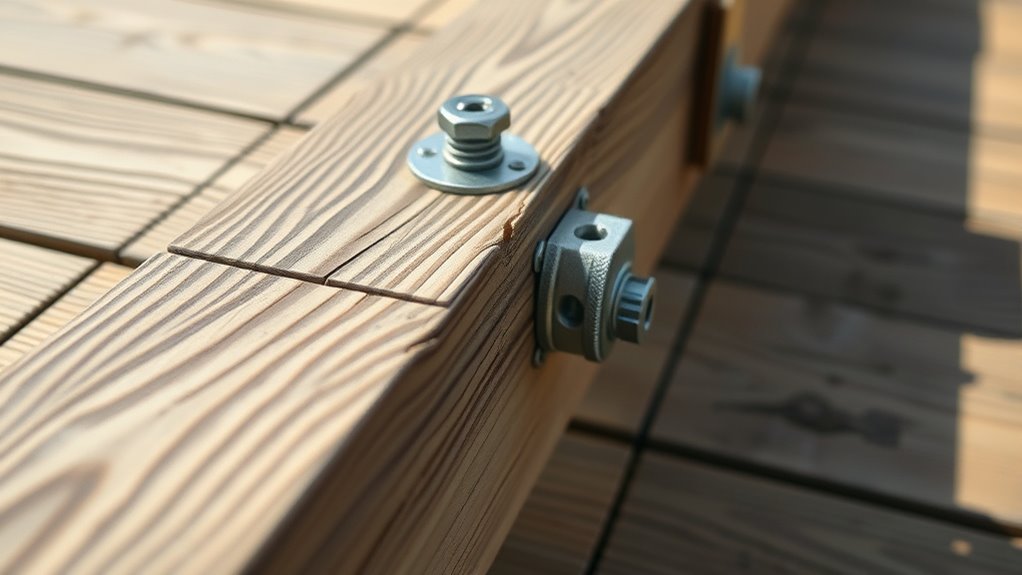
Regularly monitoring the condition of your deck edges helps catch issues early before they develop into costly repairs. Check for signs of rot, rust, or cracks around the edges, especially where the deck meets support beams. Look for loose or damaged fasteners, which can compromise stability. Keep the area clear of debris and ensure proper drainage to prevent water buildup. Schedule routine inspections, especially after storms or heavy use, to identify early damage. Maintain the integrity of your deck edges by applying protective sealants or paint as needed. Address any issues immediately—delaying repairs can lead to structural failure. Staying proactive ensures your deck remains safe, stable, and durable for years to come. Regular upkeep preserves both your investment and your peace of mind. Additionally, understanding water quality and proper drainage practices can help prevent moisture-related issues that weaken deck structures over time.
Frequently Asked Questions
How Does Weather Affect Load Capacity at Deck Edges?
Weather impacts your deck’s load capacity by causing materials to weaken or expand. Heavy rain, snow, and ice add extra weight, stressing the structure. Freezing temperatures can make wood brittle, reducing its strength. Wind can also exert lateral forces, especially at the edges. Regularly check for damage or deterioration after severe weather, and make certain your deck is properly maintained to handle these environmental stresses safely.
Are There Specific Codes Regulating Furniture Loads on Decks?
Imagine your deck as a stage where furniture plays a vital role. Yes, specific codes regulate furniture loads on decks, ensuring safety and stability. You’ll find these regulations in local building codes and standards like the IRC or IBC. They specify maximum weight limits and proper anchoring. Always check your area’s requirements before placing heavy furniture, so your outdoor space remains a safe, inviting haven for everyone.
Can Lightweight Materials Improve Edge Load Performance?
Yes, lightweight materials can improve edge load performance by reducing the overall weight on the deck, which lessens stress on support structures. When you use materials like composites or engineered wood, you make it easier for your deck to handle furniture loads safely. This also minimizes risk of structural failure and can extend the lifespan of your deck. Just guarantee these materials meet relevant building codes for safety and durability.
How Often Should Deck Edges Be Inspected for Load-Related Damage?
You should examine deck edges at least once a year for load-related damage, especially after severe weather or heavy use. Regular checks help you catch issues like cracking, warping, or loosened fasteners early. If your deck experiences frequent heavy loads or seasonal changes, consider inspecting more often—every six months. Staying vigilant ensures your deck remains safe and durable, preventing costly repairs and potential accidents down the line.
What Safety Factors Are Considered in Edge Load Design?
You should consider safety factors like material strength, expected loads, and potential impacts when designing for edge loads. These factors act as a buffer, ensuring your structure can handle unexpected stresses without failure. By incorporating conservative estimates and safety margins, you protect your deck and furniture from unforeseen overloads. This cautious approach helps maintain durability and safety, giving you peace of mind knowing your design can accommodate life’s unpredictable moments.
Conclusion
Remember, paying attention to load distribution at your deck’s edge is vital for safety. For example, if you place heavy furniture near the edge without proper reinforcement, it could lead to structural failure. Regularly inspect and reinforce these areas, especially if you add new furniture or features. By understanding loads and maintaining your deck, you guarantee it remains a safe, enjoyable space for years to come. Stay proactive, and your deck will stand strong.









